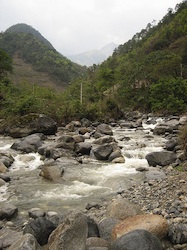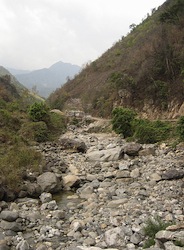Findings from scientists from Oregon State University (OSU) conclude that small hydropower projects, supported by various nations and also the Kyoto Protocol to reduce GHG emissions, may cause unintended and potentially significant losses of habitat and  biodiversity. The findings were reported in the journal Water Resources Research, in work supported by the National Science Foundation.
biodiversity. The findings were reported in the journal Water Resources Research, in work supported by the National Science Foundation.
An underlying assumption that small hydropower systems pose fewer ecological concerns than large dams is not universally valid, scientists said in the report. A five-year study, one of the first of its type, concluded that for certain environmental impacts the cumulative damage caused by small dams is worse than their larger counterparts.
The conclusions were based on studies of the Nu River system in China but the researchers say they are relevant to national energy policies in many nations or regions including India, Turkey, Latin America, that seek to expand hydroelectric power generation. Hydropower is generally favored over coal in many developing areas because it uses a renewable resource and does not contribute to global warming. Also, the social and environmental problems caused by large dam projects have resulted in a recent trend toward increased construction of small dams.
“The Kyoto Protocol, under Clean Development Mechanism, is funding the construction of some of these small hydroelectric projects, with the goal of creating renewable energy that’s not based on fossil fuels,” said Desiree Tullos, an associate professor in the OSU Department of Biological and Ecological Engineering.
“The energy may be renewable, but this research raises serious questions about whether or not the overall process is sustainable,” Tullos said.
“There is damage to streams, fisheries, wildlife, threatened species and communities,” she continued. “Furthermore, the projects are often located in areas where poverty and illiteracy are high. The benefit to these local people is not always clear, as some of the small hydropower stations are connected to the national grid, indicating that the electricity is being sent outside of the local region. The result can be profound and unrecognized impacts.”
 The OSU research teams says the study was one of the first of its type to look at the complete range of impacts caused by multiple, small hydroelectric projects, both in a biophysical, ecological and geopolitical basis, and compare them to large dam projects. It focused on the remote Nu River in China’s Yunnan Province, where many small dams producing 50 megawatts of power or less are built on tributaries that fall rapidly out of steep mountains. There are already 750,000 dams in China and about one new dam is being built every day, researchers say.
The OSU research teams says the study was one of the first of its type to look at the complete range of impacts caused by multiple, small hydroelectric projects, both in a biophysical, ecological and geopolitical basis, and compare them to large dam projects. It focused on the remote Nu River in China’s Yunnan Province, where many small dams producing 50 megawatts of power or less are built on tributaries that fall rapidly out of steep mountains. There are already 750,000 dams in China and about one new dam is being built every day, researchers say.
Among the findings of the report as it relates to this region of China:
- The cumulative amount of energy produced by small hydroelectric projects can be significant, but so can the ecological concerns they raise in this area known to be a “hotspot” of biological diversity.
- Per megawatt of energy produced, small tributary dams in some cases can have negative environmental impacts that are many times greater than large, main stem dams.
- Many dams in China are built as part of a state-mandated policy to “Send Western Energy East” toward the larger population and manufacturing centers.
- Small dams can have significant impacts on habitat loss when a river’s entire flow is diverted into channels or pipes, leaving large sections of a river with no water at all.
- Fish, wildlife, water quality and riparian zones are all affected by water diversion, and changes in nearby land use and habitat fragmentation can lead to further species loss.
- The cumulative effect on habitat diversity can be 100 times larger for small dams than large dams.
Policies encouraging more construction of small dams are often developed at the national or international level, but construction and management of the projects happen at the local level. As a result, said the scientists, mitigation actions and governance structures that would limit social and environmental impacts of small hydropower stations are not adequately implemented.

